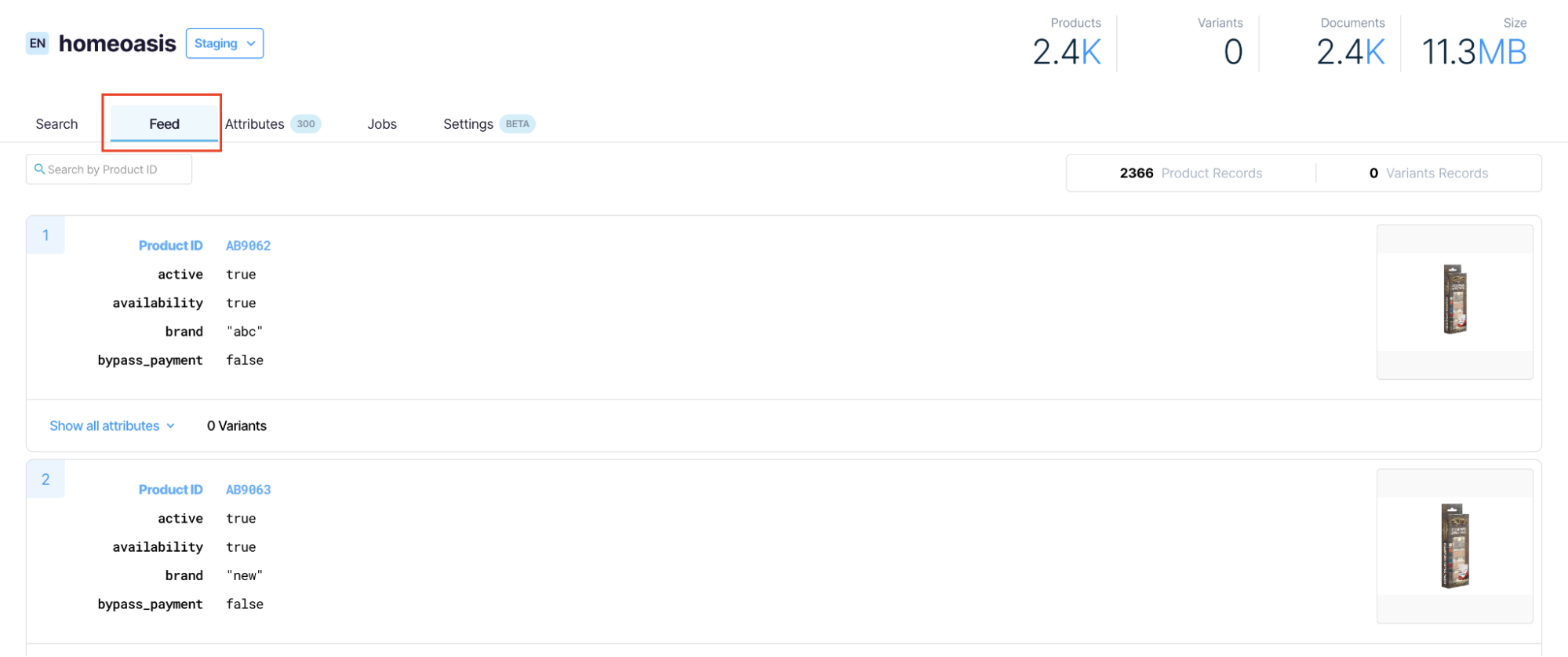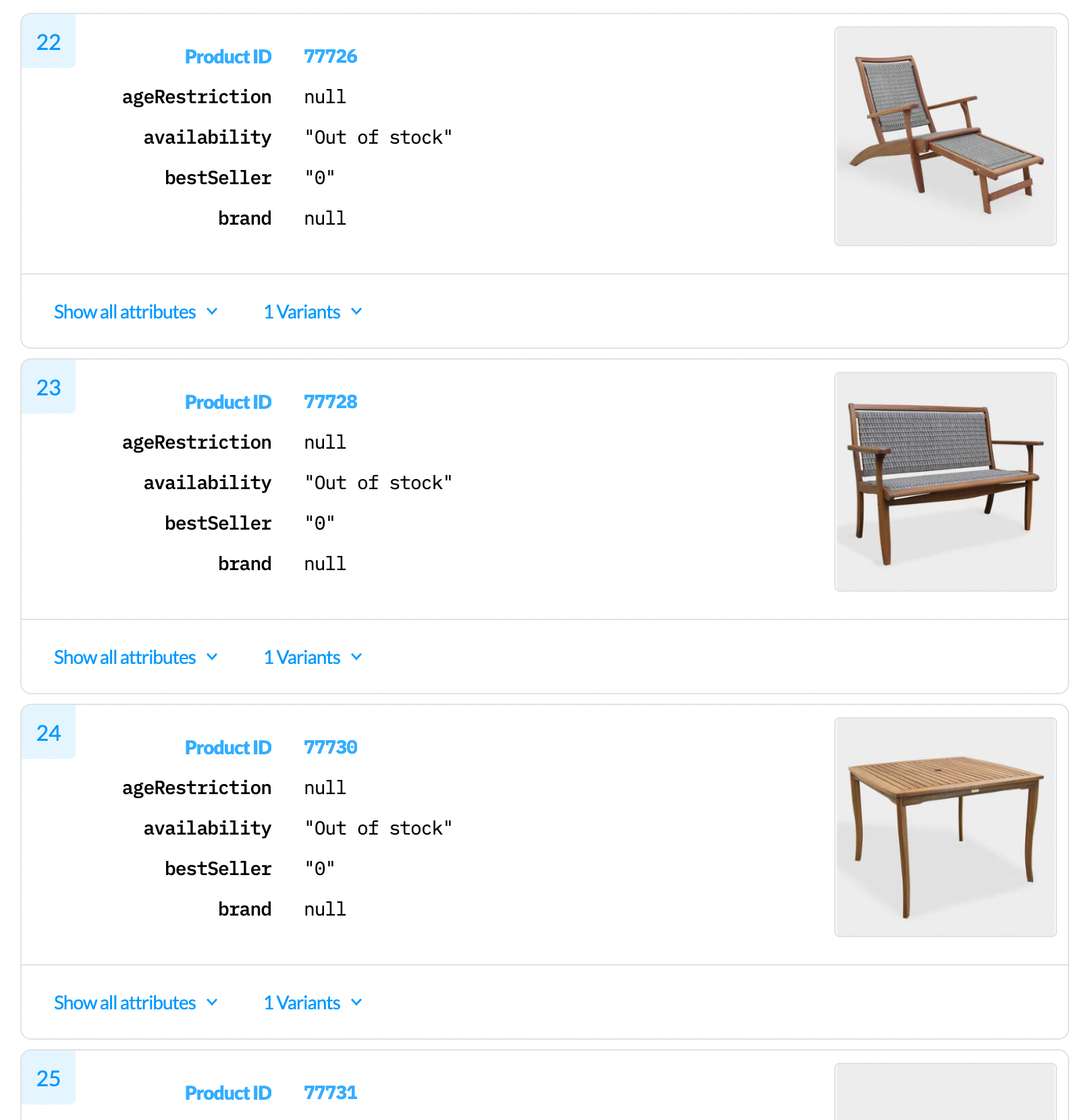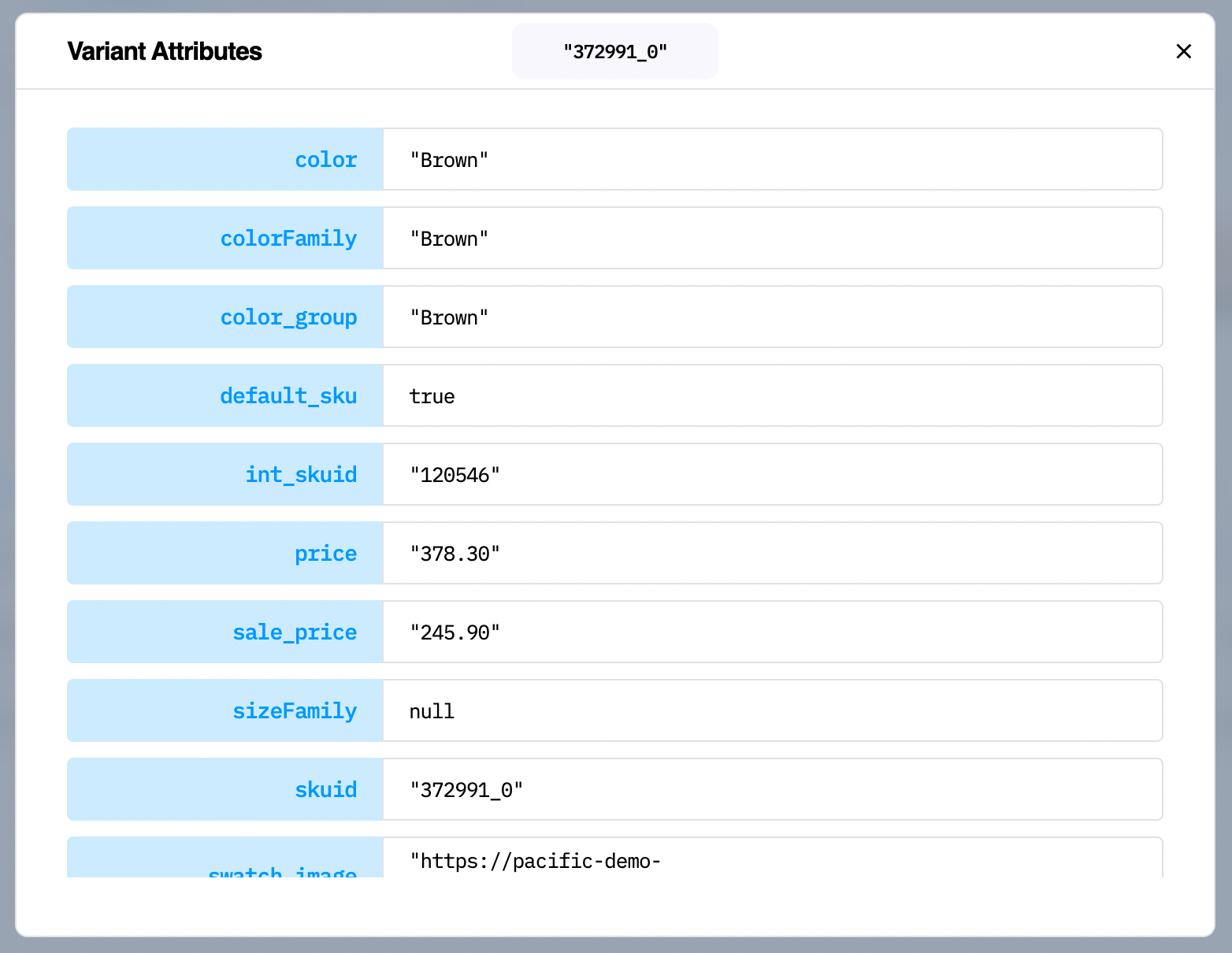Understand feed and configure attributes
This guide shows you how to understand your product feed data, customize attribute configurations, and explore catalog information using the Catalogs application.
Integration paths
Your Catalogs application experience differs based on your integration method. If you've integrated via Data hub, you manage some settings directly in Data hub Item collections rather than in the Catalogs application. Look for callouts to help you navigate both integration paths.
Prerequisites
Knowledge prerequisites
- Catalogs application: This guide introduces the Catalogs application interface and core concepts.
- Discovery glossary: Check the article to understand feed, catalog, record, and document concepts.
Access prerequisites
US-based customers
Access the Catalogs application at tools.bloomreach.com for both Production and Staging versions. Use tools-staging.bloomreach.com only if your account is unavailable on the former; using it otherwise may cause issues.
EU/UK-based customers
Access the Catalogs application at tools.bloomreach.co.uk for both Production and Staging versions. Use tools-staging.bloomreach.co.uk only if your account is unavailable on the former; using it otherwise may cause issues.
Permissions
To edit or promote configuration changes, you need a role with the appropriate catalog permissions to modify catalogs.
Understand Catalogs application interface
Go to Setup > Catalogs.
Access catalog listing
The catalog listing shows all catalogs in your account. Catalogs are account-level resources. When you select a site in the site selector dropdown, the system uses the site’s parent account.

Each catalog displays:
- Catalog name: Unique identifier used in API calls and pixel events. In certain Search APIs, this is the domain_key parameter value.
- Catalog language: Configured language.
- Catalog type: Denotes that it is a Product catalog.
- Catalog versions: Available Production and Staging environments.
View catalog version details
Each Catalog version contains high-level details such as:
Last index update
Displays when your catalog's index was last updated. Confirms your catalog is up to date.
Document count
In the standard scenario, this is the total count of unique items and item variations in a Catalog as sent in the feed and currently indexed. Includes variants, products with any availability value, and invalid items (missing title, URL, or invalid price).
This count represents Production documents. In Staging, documents cannot exceed 1.5 times the licensed Production amount.
In a multi-view override scenario, the number of documents represents the uniqueness of a product grouped into views. Suppose the product price varies across views. The price in views 1, 2, 3 is $10.99, and the price in views 4, 5, 6 is $11.99. In this case, we generate 2 documents, one for each unique grouping of views based on the product data.
Data size: Cumulative customer data across all documents in your catalog's index. This is nearly equivalent to taking each document, turning it into a JSON object, and summing the byte size of all the objects.
Note
To add an additional catalog to the account, contact Bloomreach Support and provide the language, name, and type (either Product or Content).
Explore feed data
Data hub integrations
If you have integrated with Data hub, manage feed data in Data hub Item collections application. Ensure that you have the Item Collections Admin role assigned.

Non-Data hub integrations
View catalog feed
Click a catalog to view the Feed tab, which displays raw feed records, all feed data, and the overall record counts. A catalog's feed contains the current state of the data records that have been sent in or modified via our Feed API from the source system powering this catalog.

When you're investigating data-related issues, this is your go-to spot. Use this to:
- View the current state of the feed.
- Understand what data Bloomreach has received from your source system.
- Verify that Bloomreach has all the necessary attributes for your data.
If you don't see data in the Catalog's feed and the index is up to date, then you won’t see this data in our search results or other API responses.
View product records
The Records list view shows all products and items. Records are specific to the feed and differ from documents. Feed records are turned into documents based on the catalog configuration at index update time during indexing.
The records shown remain in their raw form without any modification from the source system.
You see up-to-date records received through any full or delta feed jobs that have been successfully processed. There may be a slight delay between success and data showing in the UI, but it is minimal.
The feed records shown here are only available and reflected in search results and API responses once the catalog's index is updated. Typically, the source system will update the index by performing an Update Index API call.

Understand product details
Each record shows:
Product or item identifier (Product ID)
Product ID isn't an attribute of the record. In the feed, it displays as part of the path property. For example, if in the path property "/products/123", the product ID is 123. Bloomreach doesn't generate an ID for a record; you specify this in the feed.

Attributes
Each record lists the attributes related to that product or item. Initially, you see a set of 4 attributes in each product record. To view the complete list of attributes, click the Show all attributes dropdown.

This displays a list of all product or item-level attributes along with their corresponding values. Values that begin and end in double quotes are string values; otherwise, they are the literal JSON value supplied in the feed. Values of the data can be copied to use elsewhere.
Variants
Each record also lists the variants of the specific product/item. Click on the Variants dropdown to view each variant's attributes and identifiers. You get a grid view of all unique attributes in that product or item, like Variant ID, Color, Color Family, Color Group, Default SKU, and Integer SKUID. Click on any product variant to view all its attributes.

Search for Products/Product Variant using Product ID/ Variant ID
Use the search bar to search the feed data for a specific product ID. The same search feature is available for finding a specific variant in the list of variants. Note that the Product/Variant ID used here must be an exact match.
Configure attribute settings
The Attributes tab displays configurations for custom and reserved attributes. These configurations control how attributes behave in Search and Suggest APIs.
Based on your understanding of the current custom attribute configurations, you can choose a different setting according to your needs.
How attribute configuration work
Attribute settings control how the attribute behaves in APIs. For example, to have a custom attribute like "display_value1" appear in API responses:
- Create a custom attribute configuration for "
display_value1". - Mark it as "displayable".
- Save the change and update the index.
- Request "display_value1" in your API queries.
The index update process applies feed data against these custom attribute configurations to generate documents.
Custom attributes before configuration
All integrations
While attribute configurations may appear in the Attributes tab, you must first configure the attribute searchable, facetable, and displayable settings to use them in the Discovery APIs.
Account-specific default behavior
For certain enterprise accounts, a different default behavior may be defined for attributes that lack an explicit custom configuration. It's important to know your default account setting to understand how all your custom attributes will be treated during indexing.
Integration path differences
Data hub integrations
If you have integrated with Data hub:
-
Configure only three settings in the Catalogs application: searchable, facetable, and displayable. Note that you can configure the settings of already created attributes in Data hub Item collections.
-
Configure other properties (level, data type, multi-valued) in Data hub Item collections. Ensure that you have the Item Collections Admin role assigned.

Non-Data hub integrations
Configure all attribute settings in the Catalogs application.
Available attribute configurations
Go to the Attributes tab to see all configured custom attributes. Hover over each property to see a tooltip explanation. Configure these settings for each custom attribute. Ensure you have the Catalogs & events admin role assigned:
Level
Specifies whether the attribute appears at the product or variant level. Doesn't change where values are stored.
- Product: Attribute appears at the product level in product documents.
- Variant: Attribute appears at the variant level in variant documents.
Data hub integrations: Configure the level settings in Data hub Item collections.
Facetable
Specifies whether the attribute can be used for faceting, filtering, sorting, and merchandising rules. Also controls whether Bloomreach treats the attribute as part of the dynamic facet feature, which algorithmically determines if the attribute should be returned as a facet in API responses. Bloomreach doesn't support the pipe character (|) in facet names.
- Dynamic: Enables search features and dynamic faceting.
- Manual: Enables search features, disables dynamic faceting. Use this attribute in facet management.
- Off: Disables search features and dynamic faceting.
Displayable
Specifies whether the attribute can be returned in API responses for display in your frontend.
Product ID (pid) is the only attribute returned by default. Request additional parameters using the fl parameter in Search API calls. The attribute must be configured as displayable first.
- Checked: Returns the attribute in API responses when used in the fl parameter.
- Unchecked: Prevents returning the attribute in API responses.
Searchable
Specifies whether the attribute's value matches products or items during keyword searches. Affects recall, not ranking.
- Checked: Uses the attribute as a searchable keyword text. Checking for large or multi-value attributes can decrease the recall set relevance.
- Unchecked: Blocks the attribute from searchable keyword text.
Multi-valued
Specifies whether the attribute's value is treated as an array or a single value. Align with your feed format.
- Checked: Returns the attribute as a multi-valued array. If a record is scalar, the value becomes a single-item array.
- Unchecked: Returns the attribute as a scalar. If a record is an array, the first value becomes the scalar value.
Data hub integrations: Configure multi-valued settings in Data hub Item collections.
Data type
Specifies whether the attribute's value is treated as text or a number. Align with your feed format.
- Text: For text-type attributes.
- Number: For number-type attributes.
Data hub integrations: Configure data type in settings in Data hub Item collections.
Add new attribute configurations
To configure a new attribute:
- Click + Add an Attribute Configuration.
- Enter the attribute name.
- Duplicate attribute names aren't allowed.
- Bloomreach reserved attribute names can't be used as attribute names.
- Select the desired configurations.
- Click Save.
Change existing attribute configurations
You can rename, select/deselect existing configurations, or choose the options provided in the dropdown lists to get the desired changes. To revert the changes, click the Revert symbol.
Next steps
After configuring attributes, proceed with pushing the changes to production.
Updated 6 days ago
